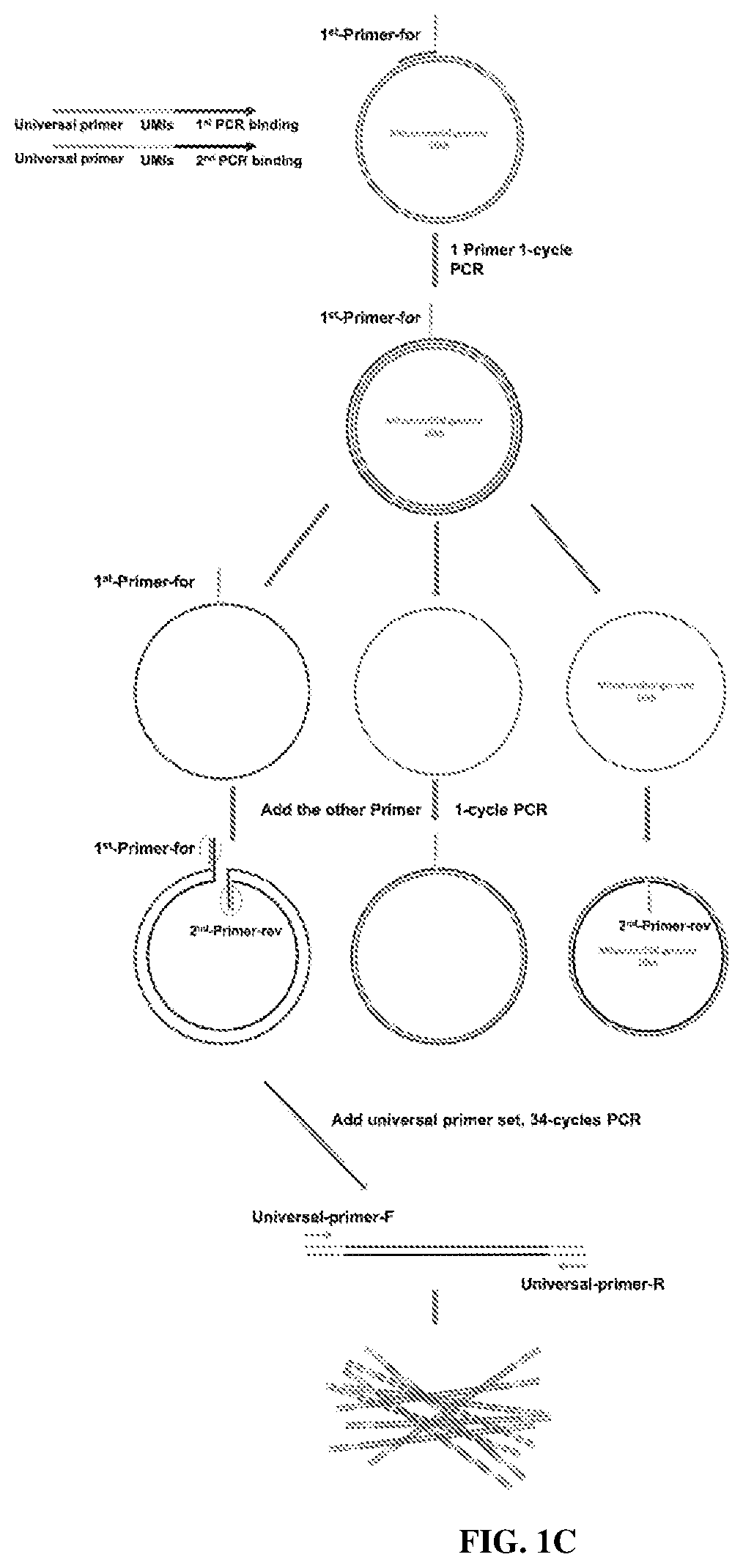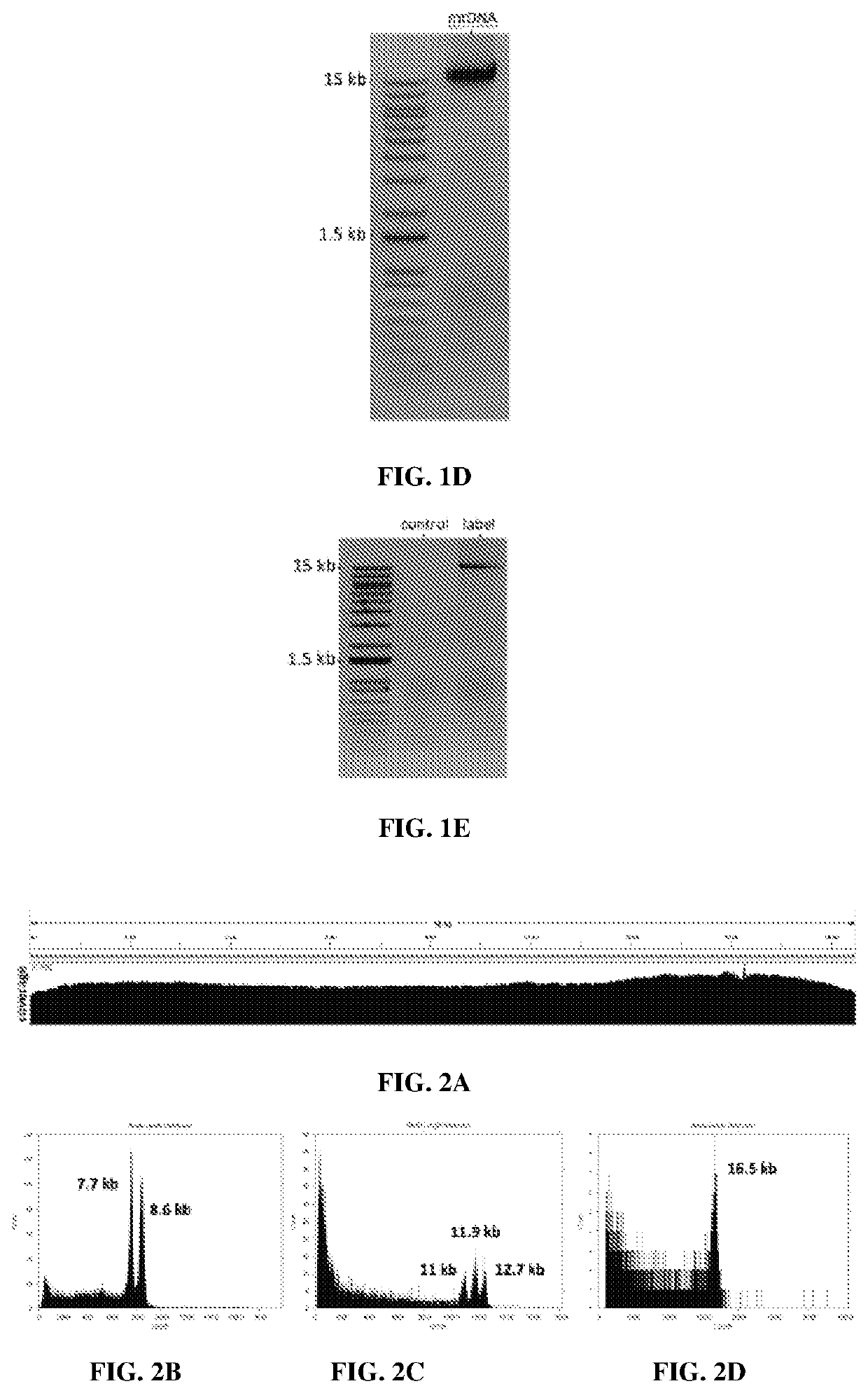Compositions and methods of labeling nucleic acids and sequencing and analysis thereof
- Summary
- Abstract
- Description
- Claims
- Application Information
AI Technical Summary
Benefits of technology
Problems solved by technology
Method used
Image
Examples
example 1
nt of a Method for Labeling Individual DNA Molecules
[0279]Methods
[0280]A PCR-directed method has been developed to label individual DNA molecules in cells. The unique molecular identifiers (UMIs) are used to correct the errors during PCR (Smith & Sudbery, Genome Res 27, 491-499, doi:10.1101 / gr.209601.116 (2017)). (FIG. 1A). In general, DNA is amplified by two rounds of one-cycle PCR with respective UMI-containing primers. After that, two universal primers are used to amplify the labeled amplicons (FIG. 1C). In the end, the labeled DNA come from different samples are pooled together to make a library that can be sequenced on a Nanopore MinION device.
[0281]The universal primers are designed to avoid non-specific amplification in either the human or mouse genome (FIG. 1E). The UMIs structure is designed to avoid secondary structure. Because this is a PCR based method, it is applicable to label any DNA in the cell.
[0282]Different polymerases were tested in the PCR reaction to efficientl...
example 2
ment of Nanopore MinION Sequencing Platform
[0285]Materials and Methods
[0286]To test the performance of Nanopore MinION sequencer in the Stem Cell and Regeneration lab, several trial sequencing runs were done on R9.4 and R9.5 flow cells with Rapid, 1D and 1D2 library preparation kits.
[0287]Results
[0288]The rapid and 1D kits are compatible with R9.4 flow cells to provide standard 1D reads (sequence one strand of input DNA), while the 1D2 kit is compatible with R9.5 flow cells to generate a mix of 1D reads and 1D2 reads (sequence one strand followed by its complementary strand). In general, the 1D and 1D2 kits provide the best yield and alignment identity of raw reads. A 24 h sequencing run using the 1D library preparation kit on a R9.4 flow cell can generate 1.4 GB of reads, while 48 hours of sequencing run using the 1D2 kit on a R9.5 flow cell can generate about 1.9 GB of reads (Table 2).
TABLE 2Summary of trial sequencing run using different Nanopore kitsLibraryRunningReadsAveragepre...
example 3
ment of an Exemplary Bioinformatics Pipeline to Analyze Long-Read Data
[0294]Materials and Methods
[0295]Nanopore sequencing is known to generate ultra-long reads which are much longer than any other sequencing platform in the market. Those reads are error prone with an average alignment identity of 82.73% (Jain et al., Nat Biotechnol 36, 338-345, doi:10.1038 / nbt.4060 (2018)). An exemplary bioinformatic pipeline using published algorithms for a proof-of-principle study.
[0296]Several of prevalent algorithms were tested to determine the performance of alignment and SNPs calling, including bwa-mean v0.7.17, minimap2.1, graphmap v0.5.2, samtools v1.9, nanopolish v0.IL0 (Jain et al., Nat Biotechnol 36, 338-345, doi:10.1038 / nbt.4060 (2018), Li, Bioinformatics 34, 3094-3100, doi:10.1093 / bioinformatics / btyl91 (2018), Sovic et al., Nat Commun 7, 11307, doi:10.1038 / ncomms11307 (2016)).
[0297]The reads in this Lest come from a multiplexed amplicon (8.6 kb and 7.7 kb) sequencing of mouse mtDNA, ba...
PUM
| Property | Measurement | Unit |
|---|---|---|
| Electric charge | aaaaa | aaaaa |
| Composition | aaaaa | aaaaa |
Abstract
Description
Claims
Application Information
 Login to View More
Login to View More - R&D
- Intellectual Property
- Life Sciences
- Materials
- Tech Scout
- Unparalleled Data Quality
- Higher Quality Content
- 60% Fewer Hallucinations
Browse by: Latest US Patents, China's latest patents, Technical Efficacy Thesaurus, Application Domain, Technology Topic, Popular Technical Reports.
© 2025 PatSnap. All rights reserved.Legal|Privacy policy|Modern Slavery Act Transparency Statement|Sitemap|About US| Contact US: help@patsnap.com



